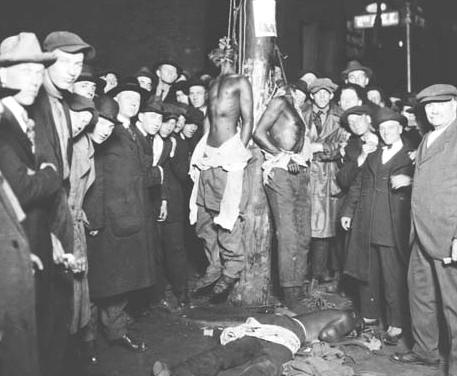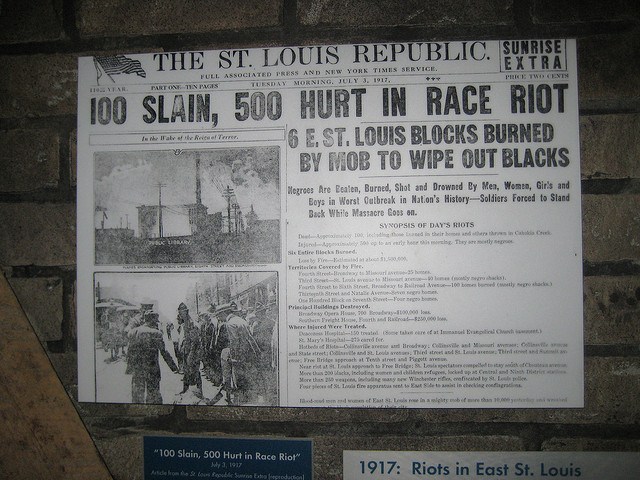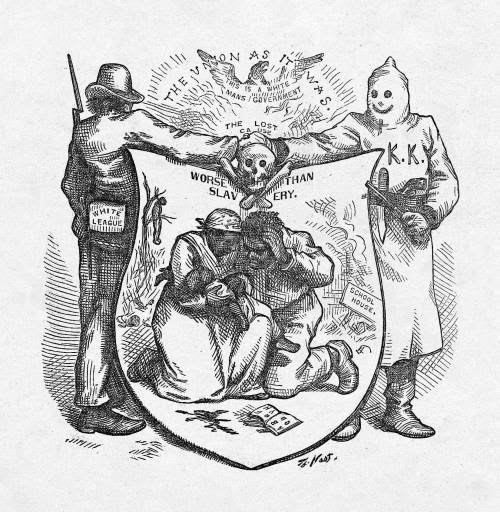In September 1868,
Southern white Democrats hunted down around 200 African-Americans in an effort
to suppress voter turnout
anniversary of the most notorious massacre in Afro-American history. It took place in Opelousas in the St Landry parish of Louisiana. Following the American Civil War (1861-65)
there followed the era of Reconstruction when
the 11 Confederate States were integrated with the North. It was an era in which the Black slaves were
freed and in which the Southern White Supremacists attempted to cling on to
their power. As Blacks were being enfranchised the old Southern White establishment reacted. It was an era of the
KKK and of many bloody
massacres and lynchings.
progressive party it should be noted that in the 19th century it was
the Republicans who were the integrationists and the Democrats who were the
bastion of White supremacy and segregation. As late as
the 1968 Presidential election Democratic segregationism was represented in
American politics by George
Wallace, the 3rd party candidate and former Governor of Alabama
who won 13.5% of the vote in the Presidential election and 32 electoral college
votes. He bears a number of similarities to Donald Trump.
anniversary of the Opelousas
massacre. It makes sober reading. Matthew Christensen writes
that:
The St. Landry Massacre is representative of the pervasive violence and intimidation
in the South during the 1868 presidential canvass and represented the deadliest
incident of racial violence during the Reconstruction Era. Southern conservatives
used large scale collective violence in 1868 as a method to gain political control
and restore the antebellum racial hierarchy. From 1865-1868, these Southerners struggled
against the federal government, carpetbaggers, and Southern black populations to
gain this control, but had largely failed in their attempts. After the First Reconstruction
Act of March, 1867 forced Southern governments to accept universal male
suffrage, Southern conservatives utilized violence and intimidation to achieve
their goals, which escalated as the 1868 presidential election neared. Violence
was nearly omnipresent in Louisiana during the presidential canvass and was the
primary reason behind the Democratic victory in the state.
 |
| A cartoon from a U.S. newspaper from 1880 reads: ’Terrorism in the South. Citizens beaten and shot at.” |
schoolhouse door by its intended recipient: Emerson Bentley, a white school
teacher. He found the message in early September 1868, illustrated with a
coffin, a skull and bones, and a dagger dripping with blood. The
straightforward message represented a menacing threat to Bentley, who was
teaching African-American children in Louisiana at the time. Little could the
Ohio-born Republican have predicted just how soon that violence would come
about.
worked as one of the editors of the Republican paper The St. Landry
Progress, was one of the few white Republicans in the Louisiana parish of
St. Landry. He and others came to the region to assist recently emancipated
African-Americans find jobs, access education and become politically active.
With Louisiana passing a new state constitution in April 1868 that included
male enfranchisement and access to state schools regardless of color, Bentley
had reason to feel optimistic about the state’s future.
nowhere near willing to concede the power they’d held for decades before the
Civil War. And in St. Landry, one of the largest and most populous parishes in
the state, thousands of white men were eager to take up arms to defend their
political power.
tumultuous one. With the help of tens of thousands of black citizens who
finally had the right to vote, Republicans handily won local and state
elections that spring. Henry Clay Warmoth, a Republican, won the race for state
governor, but the votes African-Americans cast for those elections cost them.
Over the summer, armed white men harassed black families, shot at them outside
of Opelousas (the largest city in St. Landry Parish), and killed men, women and
children with impunity. Editors of Democratic newspapers repeatedly warned of
dire consequences if the Republican party continued winning victories at the
polls.
to action and instigated violence everywhere, wrote Warmoth in his book War, Politics, and Reconstruction: Stormy Days in Louisiana.
“Secret Democratic organizations were formed, and all armed. We had ‘The
Knights of the White Camellia,’ ‘The Ku-Klux Klan,’ and an Italian organization
called ‘The Innocents,’ who nightly paraded the streets of New Orleans and the
roads in the country parishes, producing terror among the Republicans.”
widespread that they often included nearly every white man in the region. One
Democratic newspaper editor estimated that more than 3,000 men belonged to the Knights of the
White Camellia of St. Landry Parish—an area that included only 13,776 white
people in total, including women and children.
presidential elections in November, the tension only increased. On September
13, the Republicans held a meeting in the town of Washington, not far from
Opelousas, and found streets lined with armed Seymour Knights. A misfired rifle
nearly caused a riot to break out, but in the end, everyone departed
peacefully—though the Democrats threatened Bentley if he failed to publish an
“honest” account of the event in the St. Landry Progress. Sure enough, they
used Bentley’s account, in which he wrote the men had been intimidating the
Republicans, to instigate a wave of violence on September 28, 1868.
had portrayed the Democrats, Democrats John Williams, James R. Dickson (who
later became a local judge), and constable Sebastian May visited Bentley’s
schoolhouse to make good on the anonymous threats of the earlier September
note. They forced him to sign a retraction of the article, and then Dickson
savagely beat Bentley, sending the children who were sitting for lessons
scattering in terror. Rumors spread, and soon many Republicans were convinced
Bentley had been killed, though he managed to escape with his life. As a small
number of African-Americans prepared to rescue Bentley, word spread around the
parish that a black rebellion was imminent. Thousands of white men began arming
themselves and raiding houses around the area.
Negroes and rumors of an uprising in the same manner that Southerners had
reacted for generations,” wrote historian Carolyn deLatte in 1976. “If
anything, the vengeance visited upon the Negro population was greater, as
blacks were no longer protected by any consideration of their monetary value.”
group of armed African-Americans assembled to deal with the report they’d heard
about Bentley. They were met by an armed group of white men, mounted on horses,
outside Opelousas. Of those men, 29 were taken to the local prison, and 27 of them were
summarily executed. The bloodshed continued for two weeks, with
African-American families killed in their homes, shot in public, and chased
down by vigilante groups. C.E. Durand, the other editor of the St. Landry
Progress, was murdered in the early days of the massacre and his body displayed
outside the Opelousas drug store. By the end of the two weeks, estimates of the
number killed were around 250 people, the vast majority of them
African-American.
governmental organization created to provide emancipated African-Americans with
legal, health and educational assistance and help them settle abandoned lands)
sent Lieutenant Jesse Lee to investigate, he called it “a
quiet reign of terror so far as the freed people were concerned.” Influential
Republican Beverly Wilson, an African-American blacksmith in
Opelousas, believed black citizens were “in a worse condition now than in
slavery.” Another observer was led outside the town of Opelousas and shown the
half-buried bodies of more than a dozen African-Americans.
remaining sources of news in the region, as all Republican presses had been
burned—downplayed the horrific violence. “The people generally are well
satisfied with the result of the St. Landry riot, only they regret that the
Carpet-Baggers escaped,” wrote Daniel Dennet, editor of the Democratic Franklin
Planter’s Banner. “The editor escaped; and a hundred dead negroes, and perhaps
a hundred more wounded and crippled, a dead white Radical, a dead Democrat, and
three or four wounded Democrats are the upshot of the business.”
their ultimate purpose, as was borne out by the results of the November
presidential elections. Even though Republican nominee Ulysses Grant won, not a
single Republican vote was counted in St. Landry Parish. Those who oversaw the election felt “fully convinced that no man
on that day could have voted any other than the democratic ticket and not been
killed inside of 24 hours thereafter.”
local shift of power after 1868, where an instance of conservative boss rule
occurred and the parish Republican Party was unable to fully recover for the
remainder of Reconstruction,” writes historian Matthew Christensen. There would be no Republican
organization in the parish for the next four years, and no Republican paper
until 1876.
the stage for future acts of violence and intimidation. “Lynching became
routinized in Louisiana, a systematic way by which whites sought to assert
white supremacy in response to African-American resistance,” said historian
Michael Pfeifer, the author of The Roots of Rough Justice: Origins of American Lynching,
by email. “This would be an important precedent for the subsequent wave of
lynchings that occurred in Louisiana from the 1890s through the early decades
of the twentieth century, in which lynch mobs killed more than 400 persons,
most of them African American.”
deadliest instance of racial violence during the Reconstruction period, the
Opleousas massacre is little remembered today. Only slightly better known is
the 1873 Colfax
massacre in which an estimated 60 to 150 people were killed—a massacre
largely following the pattern set by Opelousas.
comparatively little until quite recently to memorialize its history of
significant racial violence,” Pfeifer said. “Reconstruction remains contested
in local memory and efforts to remember the achievements of Reconstruction are
cancelled out by the seeming failure of the period to achieve lasting change.”
to SmithsonianMag.com covering history and archaeology. She has
previously written for The Atlantic, Salon, Nautilus and others. She
is also the author of The
Last Voyageurs: Retracing La Salle’s Journey Across America. Website: http://www.lboissoneault.com/





